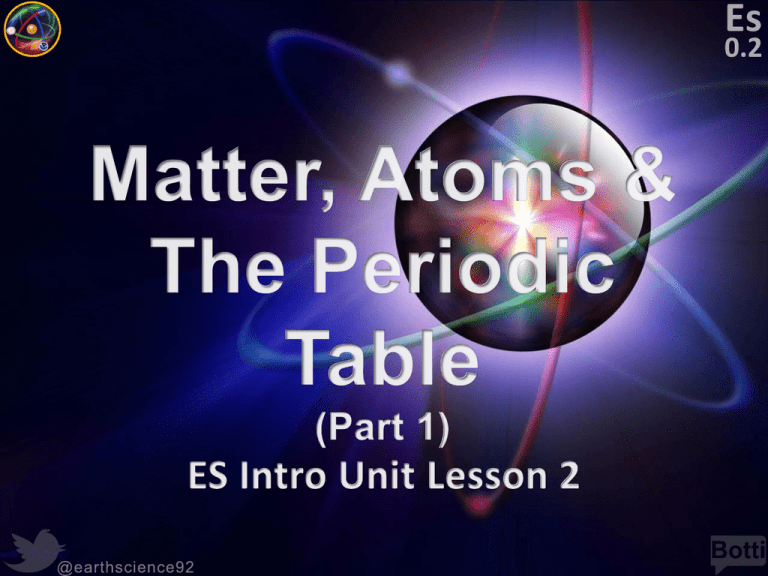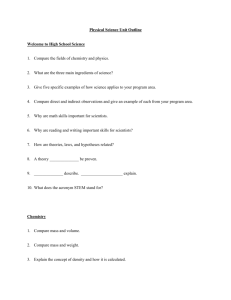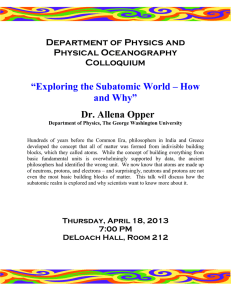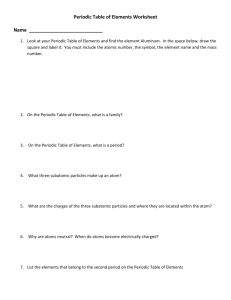Document 14149942
advertisement

• I will be able to: • Define and describe Matter. • Describe and identify the parts of an atom. • Interpret the Periodic Table. • Pick up handouts (2) • Sit quietly and copy your homework. • Guidelines and Procedures RHW Quiz & Survey due 9/9 • ES.1 Matter RHW Quiz due 9/12 Objective: I will be able to describe and define matter. What is Matter? • Matter – Anything that has mass and takes up space. – Makes up most materials. – Can you think of something that is not matter? Objective: I will be able to describe and identify the parts that make up an atom. What is Matter Composed of? • Atoms – Smallest particle into which an element can be divided and still be the same element • Building blocks of matter. • Make up everything around you. • Too small to be seen. Objective: I will be able to describe and identify the parts that make up an atom. What is Matter Composed of? Objective: I will be able to describe and identify the parts that make up an atom. What is an Atom composed of? • Parts of the Atom – Subatomic particles • Nucleus – small dense center of the atom. – Protons = Positive Charge – Neutrons = Neutral Charge • Electron Cloud- surrounds the nucleus – Electrons = Negative charge Objective: I will be able to describe and identify the parts that make up an atom. Elements Objective: I will be able to describe what an Element is & explain how to use the Periodic Table. What is an Element? • Element – A substance composed of a single kind of atom. Objective: I will be able to describe what an Element is and explain how to use the Periodic Table. What is an Element? • Atomic Number – Identifies the Element – Determined by the number of Protons. • = # of Electrons. • Example: – Cl (Chlorine) • Atomic Number = 17 • # of Protons? = Objective: I will be able to describe what an Element is & explain how to use the Periodic Table. What is the Periodic Table? Chemical Symbol •1-2 letter abbreviation •1st letter capitalized •2nd always lowercase Element Name Atomic Mass Objective: I will be able to describe what an Element is & explain how to use the Periodic Table. Determining the number of subatomic particles. • Subatomic Particles Atomic # Atomic Mass (round this number) # Protons = Atomic Number # Neutrons = Atomic Mass - Atomic Number # Electrons = Atomic Number Objective: I will be able to determine the number of protons, neutrons and electrons in an element. Determining the number of subatomic particles. • Subatomic Particles 1 H Hydrogen 1.01 Objective: I will be able to determine the number of protons, neutrons and electrons in an element. Determining the number of subatomic particles. • Subatomic Particles 2 He Helium 4.00 Objective: I will be able to determine the number of protons, neutrons and electrons in an element. Determining the number of subatomic particles. • Subatomic Particles 3 Li Lithium 6.94 Objective: I will be able to determine the number of protons, neutrons and electrons in an element. Determining the number of subatomic particles. • Subatomic Particles 4 Be Beryllium 9.01 Objective: I will be able to determine the number of protons, neutrons and electrons in an element. Determining the number of subatomic particles. • Subatomic Particles 5 B Boron 10.81 Objective: I will be able to determine the number of protons, neutrons and electrons in an element. Determining the number of subatomic particles. • Subatomic Particles 6 C Carbon 12.01 Objective: I will be able to determine the number of protons, neutrons and electrons in an element. Determining the number of subatomic particles. • Subatomic Particles 7 N Nitrogen 14.00 Objective: I will be able to determine the number of protons, neutrons and electrons in an element. Determining the number of subatomic particles. • Subatomic Particles 8 O Oxygen 15.99 • I will be able to: • Log on to Moodle, Take the • Compare/Contrast ES.1 Matter Pop Quiz compounds and mixtures. • Have page 3 from yesterday • Describe the two out. different types of mixtures. • Describe a solution. • ES.1 Matter RHW Quiz (Please have 1 attempt complete by 2night.) Final Due Date 9/12 Objective: I will be able to describe what an Element is and exiplain how to use the Periodic Table. What is the Periodic Table Objective: I will be able to describe what an Element is and exiplain how to use the Periodic Table. What is the Periodic Table? • Periodic Table – Developed by Mendeleev – Arranges elements by Atomic Number • Revealed Patterns I will be able to define and describe the differences between compounds and mixtures. What is a Compound? • Compounds • A substance made up of different kinds of atoms chemically combined. – Have different properties than the elements they are composed of. – Example: » NaCl (salt) I will be able to define and describe the differences between compounds and mixtures. How to Count Atoms? • Counting Atoms – Hydrogen (H2) • Hydrogen = – Water (H2O) • Hydrogen = • Oxygen = – Nitrogen Oxide (NO) • Nitrogen = • Oxygen = – Sugar (C6H12O6) • Carbon = • Hydrogen = • Oxygen = I will be able to define and describe the differences between compounds and mixtures. What is a Mixture? • Mixtures – Two or more substances that are combined physically, not chemically. – Particles can easily be separated. I will be able to define and describe the differences between compounds and mixtures. Compounds Vs. Mixtures • Compounds • Mixtures NaCl H 2O N2 O2 C6H12O6 NaCl + H2O N2 + O2 O2 + C6H12O6 CO2 + H2O I will be able to define and describe the differences between compounds and mixtures. What is a Mixture? • Heterogeneous Mixtures – Mixtures that lack uniform composition. – Examples: • Rocks • Sand at the beach. • Vinegar and Oil I will be able to define and describe the differences between compounds and mixtures. What is a Mixture? • Homogenous Mixtures – Mixtures that have uniform composition. – Examples: • • • • Air Corn Oil Vinegar Solutions I will be able to define and describe what a solution is. What is a Solution? • Solutions – A type of homogenous mixture. – One substance dissolved in another. • Salt Water • Coffee • Tea





